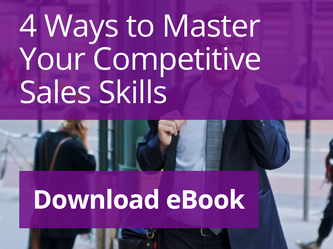Building a Better Feedback Loop
Making the presentation is only the beginning of the process! There are plenty of great presenters who also have serious difficulty actually closing the deal. Why? Because their feedback loop with the buyer needs a lot of improvement.

Too many salespeople spend a considerable amount of time preparing to present their products/services but precious little time on building the feedback loop. Getting a deal done requires plenty of “after the pitch” information from the buyer. Trying to close without that is basically flying blind. Wishful thinking and making dreamy assumptions won’t make it happen! The question “Where do I stand?” should never have a vague answer.
The best test of a feedback loop is how close the final deal matches up with the salesperson’s expectations. Whether a deal comes in as a big surprise or a tough disappointment, the fact is that the salesperson was not as engaged as they should have been. A solid feedback loop with a buyer means that there is consistent and constructive communication between both parties as the deal materializes. In addition, it’s almost impossible to forecast accurately without a reliable feedback loop.
Here are some tips on building a feedback loop that works:1. Try to establish the length of the deal cycle.
At the end of the initial presentation meeting, simply ask the buyer when you can expect the deal to close. The buyer’s response will obviously tell you how much time you have to get a deal done or if the deal is merely speculative on the buyer’s part.
2. Never offer a client additional concessions simply to justify connecting with them after the initial presentation.
Too often, salespeople get “nervous” if they haven’t heard from the buyer, and end up giving away something just for the sake of having a reason to call the buyer. If this becomes a habit, a buyer will simply wait for the salesperson to panic and thereby get concessions without even asking for them.
3. Maintain a sense of momentum by offering additional information, insights, etc. that keep the conversation going.This is both good customer service and a way to get valuable feedback about where the deal stands. Buyers simply hate “How’s it looking?” inquiries from sellers. Contacting them with fresh and valuable information, insights, suggestions is much more proactive and even welcome in many cases.
4. Probe on specific details of the deal without retreating from the original offer.This should only be done after offering that additional information. Focus on the deal points from the original presentation that the buyer may not have fully agreed with and see if they still have lingering concerns about them. This probing process should never come close to any discussion of the bottom line, but only the critical elements of the deal.
5. Follow through on any commitments made at the time of the presentation and remind the buyer that they are being delivered as promised.Quite often, sellers will be asked for more information during the initial presentation meeting. Providing it is another perfect opportunity to connect and then probe about the buyer’s take on specific components of a deal.
6. Telephone and live meetings should be utilized instead of emails whenever possible.
Verbal clues and body language are incredibly important. Buyers also tend to be very cautious if and when they respond to emails. Emails should only be used to convey objective information and data. Selling is the ultimate “people business” and voice and/or personal contact will always be crucial for gauging where the seller stands on a given deal.
Closing a sale is much easier to accomplish with a solid feedback loop. All of the potential objections will have been addressed, and “asking for the order” becomes the next logical step. The best closers know that their feedback loop is more valuable than their initial presentation in making a sale. How’s yours?
About the Author
 Buff Parham is a widely recognized thought leader and outstanding coach in the media sales and sales management field. With 35 years of sales experience, Buff has worked at Univision, FOX, Belo, ABC and CBS. He started in the mailroom at CBS, but quickly moved on to selling locally at KABC/Los Angeles and nationally for ABC Spot Sales in San Francisco, Chicago, and New York. Buff then continued on to spend almost 12 years with Univision, first as General Sales Manager at KUVN/KSTR in Dallas, and then 5 years in New York as SVP/Sales.
Buff Parham is a widely recognized thought leader and outstanding coach in the media sales and sales management field. With 35 years of sales experience, Buff has worked at Univision, FOX, Belo, ABC and CBS. He started in the mailroom at CBS, but quickly moved on to selling locally at KABC/Los Angeles and nationally for ABC Spot Sales in San Francisco, Chicago, and New York. Buff then continued on to spend almost 12 years with Univision, first as General Sales Manager at KUVN/KSTR in Dallas, and then 5 years in New York as SVP/Sales.
Buff believes that hard work matters and that raising the bar and having greater expectations tend to generate greater results. In his spare time, Buff finds cooking and playing golf to be two of the best therapies for a somewhat hectic existence!
Connect with Buff via LinkedIn
Check out Buff’s Blog www.BuffParham.com
Follow @BuffParham
About Steve Bookbinder
Steve Bookbinder is the CEO and sales expert at DMTraining. He has delivered more than 5,000 workshops and speeches to clients all over the world and has trained, coached, and managed more than 50,000 salespeople and managers. Steve continuously refreshes his training content to reflect his latest first-hand observations of salespeople across industries and regions. Through him, participants in his workshops and coaching sessions learn the best practices of today’s most successful sellers and managers across industries. Steve understands that sales is a competitive game. To outperform competitors and our own personal best results, we need to out-prospect, out-qualify, out-present and out-negotiate everyone else, not merely know how to sell. Through his specialty programs in Pipeline Management, Personal Marketing, Great First Meetings, 2nd-level Questioning, Sales Negotiating, and Sales Coaching, Steve trains sales teams to master the skills they need to overcome the challenges they face in today’s world… and keep improving results year over year.





